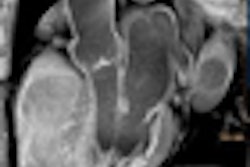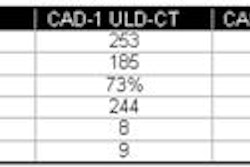Radiologists at Massachusetts General Hospital (MGH) in Boston were able to reduce pediatric CT radiation dose by up to 90% through a system of color-coded exam protocols customized to individual patients, according to an article published in the July issue of Radiology (2009, Vol. 252:1).
Much of the recent attention toward reducing pediatric CT dose has focused on jettisoning one-size-fits-all CT protocols that don't differentiate between adult and pediatric patients. MGH researchers went a step further by developing a color-coded system that makes it easier for radiology staff to remember what kinds of protocols should be used in which situations.
Although implementing the new protocols required a major change in institutional behavior over the course of two years (including a willingness to accept noisier images), MGH has found that the program has achieved good buy-in from radiologists, radiologic technologists, and referring physicians and has led to a marked reduction in radiation dose delivered to pediatric patients.
Developing the protocols
The focus of developing any CT protocol at MGH is clinical indications, according to Dr. Mannudeep Kalra, a thoracic imaging specialist. MGH pediatric imaging specialists began by asking two questions: What is the diagnostic reason for a CT exam to be ordered? And what level of image quality and detail is needed for clinical findings to be identified?
Using the example of CT scans being ordered for one patient suspected of having appendicitis and for another suspected of having a kidney stone, Kalra explained that "both patients have something wrong in their abdomens, but both have different diagnostic requirements. A kidney stone can be very easily seen, even on a low-dose image with noise. Symptoms of appendicitis require a higher radiation dose producing a sharper, more detailed image."
MGH's initiative to develop pediatric-centered CT protocols took two years, starting in 2005. For pediatric patients, new CT protocols were organized into six color zones based on the clinical indications of the patient and the number of prior CT exams performed at MGH and stored in its PACS.
Weight categories were also created. In the first two phases of protocol introduction, four categories were created. In the third and final implementation, a fifth category was added for large or heavy teenagers. The categories represented patients weighing 0-20 lb (0-9 kg), 20-57 lb (10-26 kg), 57-99 lb (27-45 kg), 99-220 lb (46-100 kg), and greater than 220 lb.
|
Colors were used to define patient categories instead of numbers to prevent confusion. The radiologists developing the protocols felt that ordering a color name and a weight category would be less confusing, according to lead author Sarabjeet Singh, a cardiovascular CT and MRI clinical research fellow.
Evaluating the protocols
Once the new low-dose protocols were developed and validated, the project team decided to introduce the protocols in three phases, with dose being reduced incrementally. This would enable the radiologists to become accustomed to the noisier images that resulted from the lower power settings on CT scanners, as well as enable them to determine how diagnostically acceptable the images were in daily clinical practice.
Image quality was also formally assessed for quality for each protocol. Two radiologists -- one, a highly experienced subspecialist, and the other, a radiologist with six years of experience -- reviewed a representative total of 113 consecutive chest and 136 abdominal CT exams produced with the three protocol phases.
For all exams, the radiologists assessed image quality in terms of diagnostic acceptability, subjective image noise, beam hardening, visibility of small structures, lesion size, lesion conspicuity, and lesion attenuation. Each element was graded using a five-point scale. Objective image nose and CT intensity in HU were measured. Radiologists were asked to draw specific regions of interest and to grade the smallest lesion they could identify.
Introducing and implementing the protocols
Prior to the launch of phase 1 of the protocols in January 2007, meetings were held with radiologists, fellows, and residents who prescreened orders for pediatric CT exams. Meetings and training sessions were also held with technologists and their supervisors in which the color codes and the requirement of weighing patients were explained.
Meetings were also held with emergency physicians, pediatricians, and specialists who treated children. The chairman of the pediatric department had been a strong proponent of the project from its inception and had been influential in convincing affiliated hospitals (Newton-Wellesley Hospital in Newton and North Shore Medical Center in Salem) to adopt the protocols.
"Pediatricians were very excited about this project. They often have to justify to a concerned parent why a CT exam is needed. Being able to tell the parent that radiation dose is adjusted to patient size and weight, and that the lowest dose possible is being utilized, mitigates some of the concern," Kalra said.
For each phase, the protocols were archived in each of the seven CT scanners used for pediatric imaging. "To keep errors to a minimum, we felt that it was imperative to enable technologists to pull up the required color zone and weight category protocol directly, rather than type scanning parameters on an individual basis," Singh explained.
Digital scales were installed in each CT suite. Colorful posters displaying the color zones and weights were hung in the CT console areas, the radiology reading rooms, the emergency department, and the pediatric department.
Ordering physicians readily adopted the new system, and most reviewed the patient's PACS folder to determine if prior CT exams had been performed before ordering an exam, as requested. Radiologists continued their practice of reviewing CT exam requests, and they also verified if prior CT exams had been performed. An online protocol system installed in the hospital's RIS software (IDXRad, GE Healthcare, Chalfont St. Giles, U.K.) facilitated selection of the appropriate color zone.
Compliance and noncompliance
To evaluate how well MGH staff complied with the guidelines, the researchers recorded patient age, sex, and weight; type of CT exam; color zone; weight category; and date of exam. Scanning parameters, CT dose descriptors, CT dose index volume in mGy, and dose length product in mGy-cm were recorded. Singh said that a CT exam was compliant with the new protocol when all scanning parameters were correctly used by the technologist for the specific color zone and weight category.
A total of 692 consecutive CT exams, performed on 438 children younger than 18 between January 2007 and May 2008, were evaluated. The findings of the evaluation indicated that compliance with the guidelines rose over time:
Assessment of 328 chest CT examinations
|
Assessment of 364 abdominal CT examinations
|
Examinations were determined to be noncompliant for the following reasons:
|
Singh and colleagues attributed the noncompliance to the fact that MGH has more than 70 CT technologists using seven different CT scanners with different detector geometry in three separate scanning locations.
In analyzing the reasons that technologists gave for not complying with the protocols, some said they were confused about the protocols for imaging teenagers approaching age 18. Others forgot to use the fifth weight category for large and obese patients when it was added in phase 3. Some expressed concerns that using the new protocols with large and/or obese children might produce diagnostically unacceptable images and used the adult protocols to which they were accustomed. Technologists were monitored for their adherence to the new protocols and received individual counseling and retraining as necessary.
The results
The radiologists found that the new protocols produced images that are diagnostically acceptable and show lesion conspicuity. Radiation dose for pediatric chest and abdominal CT studies was reduced by 16% to 89.5%.
Patients who were having their first CT exam had an average dose reduction of 55.8% for a chest exam and 41.2% for an abdominal exam. Patients having a subsequent CT had a dose reduction of 50% to 65% for chest exams and a 25% to 80% decrease for abdominal exams.
The radiology department at MGH continues to work to achieve 100% compliance with the new protocols.
"What is gratifying is that parents realize that everyone involved with CT imaging is trying very hard to do their best for the health of the child. Anecdotally, physicians no longer are hearing parents say that they are concerned about the radiation dose their children are receiving, once we have explained that we do our best to make it as low as possible," Kalra observed.
By Cynthia E. Keen
AuntMinnie.com staff writer
June 4, 2009
Related Reading
SPR news: Rads must take lead in reducing pediatric CT dose, April 23, 2009
ARRS study: Child's body shape can reduce CT dose, April 23, 2009
GE launches pediatric CT scanning protocols, January 14, 2009
Study: Radiologists dial back on pediatric CT settings, September 4, 2008
Copyright © 2009 AuntMinnie.com



















